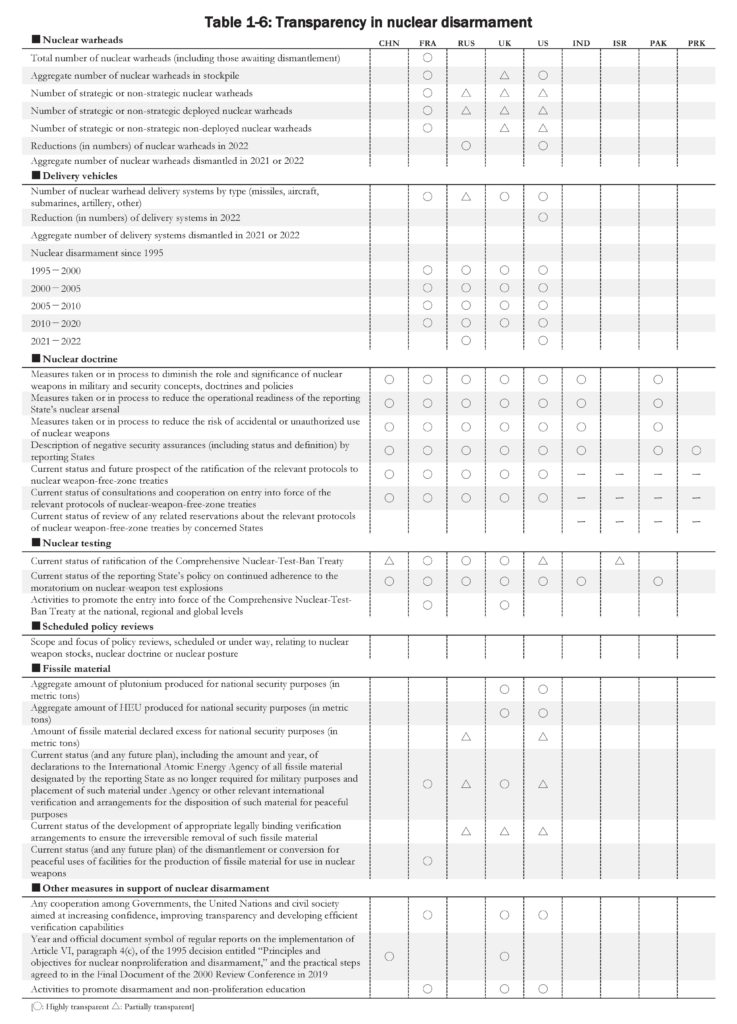Hiroshima Report 2023(10) Transparency in Nuclear Forces, Fissile Material for Nuclear Weapons, and Nuclear Strategy/Doctrine
In the Final Document of the 2010 NPT RevCon, the NWS were called upon to report on actions taken toward “accelerat[ion of] concrete progress on the steps leading to nuclear disarmament” to the 2014 NPT PrepCom (Action 5). All states parties to the NPT, including the NWS, were also requested to submit regular reports on implementing nuclear disarmament measures agreed at the previous NPT RevCon (Action 20), and the NWS were asked to agree on a standard reporting form as a confidence-building measure (Action 21). On this basis, five NWS and some NNWS (including Australia, Austria, Brazil, Canada, Germany, Iran, Japan, Kazakhstan, South Korea, Mexico, Netherlands, New Zealand, Norway, South Africa, Sweden, Switzerland and Turkey) submitted national reports to the NPT RevCon.
There were few changes in the basic policies of the five NWS regarding transparency.
As for the United States, the Biden administration, which took office in January 2021, returned to the nuclear transparency policies of the Obama administration period. In October, the NNSA declassified the number of nuclear weapons stockpile (including nuclear warheads deployed and in storage, but not those retired and awaiting dismantlement) for each year. The NNSA also declassified the number of nuclear warheads dismantled in each year.299 In the meantime, the status of nuclear weapons-related tests that did not detonate has not been updated since the first quarter of 2015, and no past information has been available since 2018.
In its Integrated Review of Security, Defence, Development and Foreign Policy published in 2021, the United Kingdom stated that “[it] will extend this long-standing policy of deliberate ambiguity and no longer give public figures for our operational stockpile, deployed warhead or deployed missile numbers.”300 In its national report submitted to the NPT RevCon, the United Kingdom stated that it “tabled a draft of its national implementation report at the third session of the Preparatory Committee, and conducted an extensive consultation exercise involving the other nuclear-weapon States, non-nuclear weapon States and civil society as it prepared the final version that has been published ahead of the Review Conference.” It also “[called] on all States parties to submit regular reports on their implementation of the Treaty and of commitments made at previous Review Conferences, in line with action 20 of the 2010 action plan, and decide to set aside time in the forthcoming review cycle for examination and discussion of those reports.”301 The United Kingdom argued the limitation of transparency as follows:
It is important to emphasize that there are limits to transparency. In all cases, transparency must not extend to sharing information that is proliferation-sensitive. There are also important national security reasons for not exposing information that would be valuable to State or non-State adversaries. In addition, many nuclear-weapon States, including the United Kingdom, incorporate a degree of deliberate ambiguity into their nuclear doctrines, which enhances deterrence and contributes to strategic stability. In those cases, increasing transparency could paradoxically reduce security and stability. It is important, though, that those elements are clearly signalled and explained; deliberate ambiguity cannot be an excuse for a lack of transparency or accountability.302
China, which has been criticized for being less transparent on nuclear issues than other nuclear-weapon states, argued that it “[has] always believed that transparency of intentions and policies has the greatest practical meaning,” and stated, “With regard to nuclear transparency measures, States must fully consider the differences among the nuclear-weapon States in the sizes of their nuclear forces, their basic nuclear strategies and policies, and their strategic security environments, and accept the resulting differences in transparency and focus.”303 China mainly refers to and summarizes its past efforts regarding the three pillars of the NPT, as well as its policy direction, including its national report submitted to the NPT RevCon. In terms of nuclear strategy and doctrine, there is a strong sense of repetition of the existing declaratory policy. Furthermore, no reference was made to the type and number of its nuclear arsenals, or its concrete plans for modernizing its nuclear forces. At the 2012 NPT PrepCom, the NPDI proposed a draft form for reporting on nuclear warheads, delivery vehicles, fissile material for nuclear weapons and nuclear strategy/policies.304 Using that draft form, the following table summarizes the degree of transparency taken by the nuclear-weapon/armed states.
299 NNSA, “Transparency in the U.S. Nuclear Weapons Stockpile.”
300 United Kingdom, Global Britain in a Competitive Age, p. 77.
301 NPT/CONF.2020/WP.42, December 21, 2021.
302 NPT/CONF.2020/WP.42, December 12, 2021.
301 NPT/CONF.2020/WP.42, December 21, 2021.
302 NPT/CONF.2020/WP.42, December 12, 2021.
303 NPT/CONF.2020/41, November 16, 2021.
304 NPT/CONF.2015/PC.I/WP.12, April 20, 2012.






